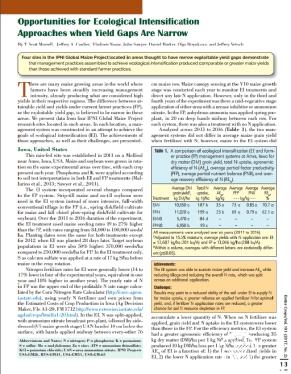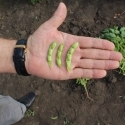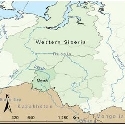Opportunities for Ecological Intensification Approaches when Yield Gaps Are Narrow

There are many maize growing areas in the world where farmers have been steadily increasing management intensity, already producing what are considered high yields in their respective regions. The difference between attainable yield and yields under current farmer practices (FP), or the exploitable yield gap, is believed to be narrow in these areas. We present data from four IPNI Global Maize Project research sites located in such areas. In each location, a management system was constructed in an attempt to achieve the goals of ecological intensifi cation (EI). The achievements of those approaches, as well as their challenges, are presented.
Iowa, United States
This rain-fed site was established in 2011 on a Mollisol near Ames, Iowa, USA. Maize and soybean were grown in rotation on the same experimental areas over time, with each crop present each year. Phosphorus and K were applied according to soil test interpretations in both EI and FP treatments (Mallarino et al., 2013; Sawyer et al., 2011).
The EI system incorporated several changes compared to the FP system. Strip-till maize and no-till soybean were used in the EI system instead of more intensive, full-width conventional tillage in the FP (i.e., spring disk/fi eld cultivate for maize and fall chisel plow-spring disk/fi eld cultivate for soybean). Over the 2011 to 2016 duration of the experiment, the EI treatment used maize seeding rates 19 to 27% higher than the FP, with rates ranging from 84,000 to 100,000 seeds/ha. Planting dates were the same for both treatments except for 2012, when EI was planted 28 days later. Target soybean populations in EI were also 50% higher: 370,000 seeds/ha compared to 250,000 seeds/ha for FP. In the EI treatment only, S as calcium sulfate was applied at a rate of 17 kg S/ha before maize in the crop rotation.
Nitrogen fertilizer rates for EI were generally lower (14 to 17% lower in four of the experimental years, equivalent in one year and 18% higher in another year). The yearly rate of N in FP was the upper end of the profi table N rate range calculated by the Corn Nitrogen Rate Calculator (http://cnrc.agron.iastate.edu), using yearly N fertilizer and corn prices from the Estimated Costs of Crop Production in Iowa (Ag Decision Maker, File A1-20, FM 1712 http://www.extension.iastate.edu/agdm/crops/html/a1-20.html). In the EI, N was split-applied, with ammonium nitrate broadcast pre-plant, followed by sidedressed (V5 maize growth stage) UAN banded 10 cm below the surface, with bands applied midway between every-other 76 cm maize row. Maize canopy sensing at the V10 maize growth stage was conducted each year to monitor EI treatments and direct any late N application. However, only in the third and fourth years of the experiment was there a mid-vegetative stage application of either urea with a urease inhibitor or ammonium nitrate. In the FP, anhydrous ammonia was applied spring preplant, in 20 cm deep bands midway between each row. For each system, there was also a treatment with no N application.
Analyzed across 2011 to 2016 (Table 1), the two management systems did not differ in average maize grain yield when fertilized with N; however, maize in the EI system did accumulate a lower quantity of N. When no N fertilizer was applied, grain yield and N uptake in the EI system were lower than those in the FP. For the effi ciency metrics, the EI system had a greater agronomic effi ciency of N (AEN), producing 35 kg dry matter (DM)/ha per 1 kg N/ha applied. The FP system produced 10 kg DM/ha less per 1 kg N/ha applied. The greater AEN of EI is a function of: 1) the lower unfertilized yields in EI, 2) the lower N application rates in EI, and 3) the greater grain yield response to N in EI. No differences existed between EI and FP for the other efficiency metrics: partial factor productivity (PFP), partial nutrient balance (PNB), or recovery efficiency of N (REN).
Rostov Oblast, Southern Russia
This study began in 2011 in the District of Tselina in Rostov Oblast, Southern Russia. The clay loam soil at this low rainfall research location is classifi ed as an ordinary Chernozem (Voronic Chernozem Pachic in WRB, 2006) – a soil sharing many characteristics with the Mollisol order in the USDA Soil Taxonomy. Normal weather patterns result in low rainfall and high temperatures during pollination. At the start of the experiment, the calcareous soil tested medium in P, very high in exchangeable K, a basic pH (7.9), and an organic matter content of 2.9%. Soil tests were taken to a depth of 20 cm. Maize and soybean were initially planted in 2011 after winter wheat and were thereafter grown in rotation with soybean from 2011 to 2014. In 2014, the soybean crop was heavily infected with the soybean mosaic virus (SMV) and was destroyed in July. No yield measurements were taken that year. Starting in 2015, chickpea became the rotational crop.
Like other Global Maize locations, two management systems were compared: FP and EI. Within each management system, N response was tested in sub-plots without N (N1) and with N (N2), resulting in four treatments: FP-N1, FP-N2, EI-N1, and EI-N2 (Table 2). Both maize and the rotational crop (soybean and chickpea) were fertilized. From 2011 to 2013, the same maize hybrids were used for both management systems. New, shorter season hybrids have been planted in EI since 2014 and in FP since 2016.
Soybean was the rotational crop in 2011-2014. Chickpea was the rotational crop from 2015-2016. Seed treatments included Zn, Mo, and in the fi rst soybean season and each chickpea season, a rhizobium inoculant.
Maize fertilization practices for FP were selected from those used in large scale farms and agricultural enterprises near the study location. In the FP-N1 treatment, MAP was broadcast before planting at a rate supplying 9 kg N/ha and 40 kg P2O5/ha. In FP-N2, ammonium nitrate, also broadcast pre-plant, was added to supply a total of 30 kg N/ha and 40 kg P2O5/ha.
Maize fertilization practices for EI were determined from accompanying, controlled studies. These studies demonstrated that higher N and P rates as well as K addition were needed, even though soil test K levels were high. The rate of K was split across two applications. Fertilization in EI was done at two to three different times. In EI-N1, MAP and KCl were broadcast before planting to supply 12 kg N/ha, 50 kg P2O5/ha, and 20 kg K2O/ha. In EI-N2, ammonium nitrate was added to supply an additional 38 kg N/ha. At planting, in both EI-N1 and EI-N2, a Zn seed treatment was used along with an application of MAP and KCl banded 2 cm to the side of the seed row, at rates of 5 kg N/ha, 20 kg P2O5/ha, and 20 kg K2O/ha. In only EI-N2, an additional 30 kg N/ha was side-dressed as ammonium nitrate at maize growth stage V3 to V5.
Soybean fertilization practices in 2011 to 2014 also differed among treatments. Fertilizers were broadcast before planting in all treatments. The FP-N1 treatment applied MAP at 9 kg N/ha and 40 kg P2O5/ha, and the FP-N2 applied an additional 11 kg N/ha as ammonium nitrate. In EI-N1, MAP and KCl were applied at rates supplying 10 kg N/ha, 45 kg P2O5/ha, and 30 kg K2O/ha. The EI-N2 treatment added an additional 20 kg N/ha. In the fi rst soybean season, a rhizobium inoculant was applied to the seed in both EI-N1 and EI-N2. In all soybean seasons, Mo was added as a seed treatment in both EI-N1 and EI-N2.
After the failure of the soybean crop in 2014 from SMV, chickpea became the rotational crop. Fertilizers were broadcast before planting chickpea in all treatments like for soybean. The FP-N1 treatment applied MAP at 6 kg N/ha and 26 kg P2O5/ha, and the FP-N2 applied an additional 18 kg N/ha as ammonium nitrate. In EI-N1, MAP and KCl were applied at rates supplying 12 kg N/ha, 52 kg P2O5/ha, and 30 kg K2O/ha. The EI-N2 treatment added an additional 12 kg N/ha. In both chickpea seasons, a rhizobium inoculant and seed treatment with Mo were used in both EI-N1 and EI-N2.
The highest average grain yield of maize of 5,750 kg DM/ha was obtained through a locally adapted EI management strategy that included: balanced application of N, P, and K; split N applications; use of a P, K, and Zn at planting; and during the last three years of the study, new shorter-season hybrids (Table 3). The average improvement of EI over FP was 9%. Maize responded only slightly to added N in both the EI and FP management systems. The average yield increase due to N was 6%. Adequate nitrate-N levels in the soil may explain this low response. These results demonstrated the need to determine the best N rates to apply in this region, and those experiments have been initiated. The highest average grain yield of soybean of 1,700 kg DM/ ha was also obtained through EI management including balanced application of N, P, and K fertilizers, Mo seed treatment, and inoculation (in the fi rst season). The improvement over FP (N9P40) reached 25%. The yield response to additional N over the low N treatment, for both the EI and FP management, ranged from 6 to 7% and was not signifi cant during all seasons. Improvements in seed protein were obtained with both EI and FP management treatments that provided extra N fertilizer. In addition, soybean oil output was also slightly increased due to higher yield obtained with extra N.
Based on the two-season data, chickpea performs noticeably better than soybean in the low rainfall experimental location. Again, the highest average yield of chickpea of 2,420 kg DM/ha was obtained through EI management including balanced application of N, P, and K fertilizers, Mo seed treatment, and inoculation each season. The improvement over FP (N6P26) reached 27%. The yield response to additional N over the low N treatment under the EI and FP management ranged from 6 to 15%, respectively, and was signifi cant during both seasons.
Minnesota, United States
There are two research sites in this project. In 2013, an experiment was established on a rain-fed, tile-drained clay loam Mollisol in south-central Minnesota, USA, near Waseca. In 2014, a second experiment was established on an irrigated loamy sand Mollisol in central Minnesota near Becker. Maize is produced continuously in each experiment. Each experiment compared FP to EI management systems, developed in consultation with researchers, crop advisers, and farmers.
Each experiment used a disk-rip tillage system and received a pre-plant application of S at 17 and 22 kg S/ha at Waseca and Becker, respectively. At both locations, a solution of N (5 kg N/ha) and P (18 kg P2O5/ha) was applied in-furrow during planting.
Compared to the FP system, EI had 40% of maize stover harvested after grain harvest and before fall tillage, in combination with a longer-season hybrid and a 14% greater planting density (101,000 seeds/ha).
Two nutrient management approaches (standard and advanced) were evaluated within both the EI and FP systems. Standard nutrient management followed university guidelines for nutrient management (Kaiser, 2011). The advanced nutrient management treatment had P and K applied at rates of removal by grain.
Nitrogen management with standard and advanced approaches differed between the two sites. These applications were in addition to the N applied in the furrow at planting. At Waseca, the standard approach had 180 kg N/ha applied preplant as urea. The advanced approach utilized split-application of N. Urea was applied pre-plant at 152 kg N/ha. At planting, a solution of ammonium thiosulfate (ATS) and UAN was applied in a band placed on the surface 5 cm to the side of the row at 27 kg N/ha. The fi nal 45 kg N/ha was sidedressed at the six leaf-collar maize stage as UAN injected midway between the 76-cm rows.
At Becker, the coarse-textured soil warranted in-season split application of N with both nutrient management approaches. The standard approach used sidedressed applications of urea at early (two and six leaf-collar) maize stages (45 and 185 kg N/ha, respectively). The advanced approach applied 27 kg N/ha in a band on the surface 5 cm to the side of the row at planting, using a solution of ATS and UAN, as at Waseca. Subsequent urea applications were made at the six leaf-collar, twelve leaf-collar, and tasseling maize stages at 78, 85, and 39 kg N/ha, respectively.
Results from 2013 to 2016 at Waseca and 2014 to 2016 at Becker are summarized in Table 4. In a region with a long history of intensive maize production and high yields, substantial yield increases were possible at both locations with improved agronomic and nutrient management practices. At both locations, advanced nutrient management combined with the EI management system (EI/advanced) produced greatest maize grain yield; however, the standard nutrient approach combined with the EI system (EI/standard) produced the greatest improvement in economic net return. The EI/standard combination improved net return in three of four years at Waseca and in all three years at Becker. It also had the greatest AEN and REN at Waseca and the second-greatest AEN and REN at Becker.
Moving to an advanced nutrient management approach without other agronomic changes (the FP/advanced combination) was not as consistently or overall profi table at either site as changing agronomic practices and staying with standard nutrient management (the EI/standard combination). At Waseca, the FP/advanced combination produced yields equivalent to the EI/standard combination. Compared to the FP/standard combination, the FP/advanced combination improved REN, but did not improve AEN and consistently reduced net return. At Becker, the FP/advanced combination increased net return in two of three years, but had less overall net return compared to the EI/standard combination. It did, however, increase REN with similar yield and AEN compared to the EI/standard combination.
No one combination of agronomic and nutrient management produced the greatest performance across all metrics of cropping system performance. At both locations, the EI/standard combination was most profi table while the EI/advanced combination had the highest yield and N use effi ciencies. Results from this study demonstrate potential for improvement in corn yield and N use effi ciency in environments where customary practices produce high grain yield (>9 t DM/ha). Weather and crop responses are dynamic over time. Additional years of research will provide greater understanding of where, when, and to what extent advanced nutrient and agronomic management approaches can narrow yield gaps while limiting economic risk and enhancing environmental stewardship.
Summary
Three research sites in the states of Iowa and Minnesota in the USA, as well as one research site in Southern Russia demonstrate that EI produces maize yields comparable to or exceeding those obtained in FP; however, achievement of other goals such as increased nutrient use effi ciency has not always occurred. All four sites are combining what are thought to be improvements to nutrient management with improvements to other agronomic practices. Such integration is vital to achieving other goals beyond just yield increases. Several achievements have occurred, but many challenges remain.
Dr. Murrell is IPNI Potassium Program Director; E-mail: smurrell@ipni.net. Dr. Coulter is Associate Professor and Extension Agronomist Department of Agronomy and Plant Genetics, University of Minnesota; E-mail: jeffcoulter@umn.edu. Dr. Nosov is Director, IPNI Southern and Eastern Russia Region, Krasnodar; E-mail: vnosov@ipni.net. Dr.Sawyer is Extension Soil Fertility Specialist and Professor, Department of Agronomy, Iowa State University; E-mail: jsawyer@iastate.edu. Dr.Barker is Assistant Scientist, Department of Agronomy, Iowa State University; E-mail: dbarker@iastate.edu. Dr. Biryukova is Professor, Department of Soil Science and Land Recourses Evaluation, Southern Federal University, Rostov-on-Don; E-mail: olga_alexan@mail.ru Mr. Vetsch is Researcher, Southern Education and Outreach Center, University of Minnesota; E-mail: jvetsch@umn.edu.
References
Kaiser, D.E., J.A. Lamb, and R. Eliason. 2011. Fertilizer recommendations for agronomic crops in Minnesota. BU-06240-S. Univ. of Minnesota Ext., St. Paul. http://www.extension.umn.edu/agriculture/nutrient-management/nutrient-lime-guidelines/fertilizer-recommendations-for-agronomic-cropsin-minnesota/docs/BU-6240S-PUB.pdf (accessed 13 Mar. 2017).
Mallarino, A.P., J.E. Sawyer, and S.K. Barnhart. 2013. A general guide for crop nutrient and limestone recommendations in Iowa. Rev. Oct. 2013. Iowa State University Coop. Ext., Iowa State University, Ames, Iowa, USA. Available at https://store.extension.iastate.edu/Product/pm1688-pdf (accessed 3 Apr. 2017).
Sawyer, J.E., A.P. Mallarino, R. Killorn, and S.K. Barnhart. 2011. A general guide for crop nutrient and limestone recommendations in Iowa. Reprinted April 2011. Iowa State University Coop. Ext., Iowa State University, Ames, Iowa, USA.




